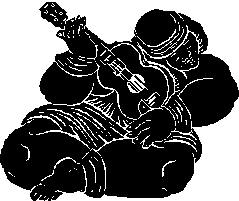
Music Ministry

Music Ministry
Lokomaikaʻi
ʻAha Hīmeni Songfest  ** You'll need to have an Hawaiian Font in your system to
read the diacriticals correctly.
The Lokomaikaʻi 'Aha H´meni Songfest is a project
of H.A.L.I.A. (Hawaiian Arts & Liturgical Inculturation Awareness)
** You'll need to have an Hawaiian Font in your system to
read the diacriticals correctly.
The Lokomaikaʻi 'Aha H´meni Songfest is a project
of H.A.L.I.A. (Hawaiian Arts & Liturgical Inculturation Awareness)
Composers & Arrangers
At the 2004 ʻAha Hīmeni
Songfest, we will feature some o the composing artistry of one of Kauaʻi's
renowned haku mele.
(following excerpted from the Kauaʻi Historical Society, 1998, with
additions from Rob's interview with Hale Sylvester in 2004)
Henry Wilfred Waiaʻu (1889-1949)
The ʻāina hānau
or birthplace of Henry Wilfred Waiaʻu is a wahi pana- a legendary place that has
long been celebrated for its calm waters and rosy cloud banks. Originally from
the fishing village of Hoʻokena in South Kona, Hawaiʻi, Henry Waiaʻu was born on
February 8, 1889, as the second child of Gersham Kelekoma Waiaʻu and Haole
Kaupu.
Henry Waiaʻu attended the Kamehameha School for Boys, where he graduated with
the Class of 1908. It is there that he initially received formal music training
and the needed skills to excel at reading, writing and arranging music
compositions. After Kamehameha, he worked as a roadman for the US Geological
Survey, and in 1914 was a clerk to William Henry Rice. Successive jobs included
bailiff, employment at the County Treasury Dept., Board of Harbors Commission
and the Dept .of Public Works. He enlisted for a short stint in the US Army in
1918. All the while his musical quest for excellence continued. Songwriting and
arranging music soon became a favorite past-time for him. He had excellent
musical penmanship, and beautifully transcribed his own musical works.
Several years later, he met a Kauaʻi woman by the name of Lydia Kaluapiʻilāhainā
Ellis. They were married on June 20, 1920 at Lawaʻi,
Kōloa.. Together, the couple raised four
children. which included Edgar Miki, Leopold Puʻ unoni, Pearl Kapika and Mildred
Haleakalā. They were all musically talented..
As a Hawaiian song writer; Henry Waiaʻu regularly composed and arranged songs as
gifts that he dedicated to the classes of his children. For Leopold's Kamehameha
Schools Class of 1941 he composed, "Kona Kai ʻŌpua," and for Haleakalā's
Kamehameha Schools Class of 1945 he composed, "Kuʻu Home O Kamehameha." More
often than not, he composed songs and gave them away with love to friends and
family.
Henry Waiaʻu's passion always remained close to church and music. In his later
years, he served as the Kahu for the Hanapēpē
Hawaiian Church. He particularly loved church hymns. The selections that he
especially enjoyed were translated into the Hawaiian language, then put to
special arrangements for the congregation to sing as part of their weekly
services. He was also the choir director of the Līhuʻe
Hawaiian Church for many years. In 1925, he specially composed
the song, "Lei I Ka Mokihana", which won his choir the top accolades at the
Territorial Singing Contest that was held at the Oliver's Tabenacle (i.e.,
Kawaiahaʻo Church) in Honolulu. From Nāwiliwili
to the fragrant dainty-leafed maile, Henry Waiaʻu's deep love for Kaua'i will
always live on through his songs.
E Hauoli Ē
One of Henry's largest religious works ("E Hauʻoli
Ē") was originally composed for a Hīmeni
Hoʻokūkū
(Choir Competition) for the Territory-wide Congregational Church community in
1927. It celebrates the anniversary of Kawaiahaʻo's consecration as a place of
Christian worship, metaphorically comparing its members to the sparkling stars
of early dawn. The Mendelssohn-like setting includes march-like figures proudly
exhorting the faithful to came to God's house with singing, joy, and praise.
What is most surprising is the central fugal section which is unique in its
contrapuntal setting of Hawaiian text, a somewhat technically demanding
challenge to the average choir. Henry's prize-winning Līhuʻe
Church choir group was renowned in the mid 1920's for their choral beauty,
discipline, and ability to present new Hawaiian works to the community, both
sacred and secular. There is a famous 1925 picture of them in the Hawaiian language
newspaper. Tonight's arrangement is a 4-part reduction of the original,
as Henry's original setting was for a double choir of 8 vocal parts. This
arrangement captures the same spirit ands enthusiasm of those heady mid 20s,
when Hawaiian politicians successfully vied for Territorial office by having
their own Hawaiian campaign songs (even Henry wrote one), nearly a half-dozen
Hawaiian language newspapers thrived, where the outside world clamored to spend
vacation time in our famous paradise, serenaded by world-famous local musicians
and their still-famous songs. The "roaring twenties" were aptly named, and
Hawaii's enthusiasm for the times was no less engaging. Translation of "E Hau'oli
Ē"
Rejoice, o ye faithful, how joyous! Let all everywhere sing
in honor of Kawaiahaʻo Church
(Sing) for the glorious church of God
Lift high the torch of righteousness
Come to Zion to praise the glorious King of Kings
Hearken and give thanks for the glorious church of Kawaiahaʻo
Greatly brilliant are the morning stars at dawn
within the glorious walls of Kawaiahaʻo's Church.
Rejoice in song, o ye faithful everywhere, of Kawaiahaʻo's everlasting glory!
(rmm)
The choirs will also sing Psalm 84 "How Lovely is Your Dwelling Place", based on
Waiaʻu's song "Kaʻililauokekoa", which, by the way, was debuted in a church
choir venue not unlike ours this evening. The joyful verses are gracefully
counter-balanced by an original antiphon by R. Mondoy. Our Gathering Song,
"God's Kingdom Is Upon Us", is an Anglican Church hymn-text to the tune of
Waiaʻu's song "Kauaʻi Beauty", dating from 1929. Mahalo to Hale Sylvester for
permission of use her Dad's tunes for our use in a sacred-music setting.
Go to Mondoy Music Web Page Index (at the left) for more options